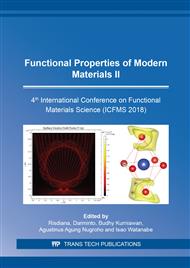p.409
p.415
p.422
p.428
p.433
p.437
p.444
p.451
p.456
Characteristics of CMC from Corncob and its Application as Electrode Binder in Lithium Ion Battery
Abstract:
Corncobs are a waste product from corn farming that are abundant in Indonesia. Corncobs have a high cellulose content, more than 40%, which made it useful for synthesizing CMC. CMC is a cellulose derivative that is widely used in many industries such as food, pharmaceutical, detergent, textile, cosmetic product and binder. In this paper, we use CMC that are synthesized from corncobs as binder in the electrodes of lithium ion battery. The steps of synthesizing CMC from corncobs started with the isolation of the cellulose, then followed by the processes of alkalization, carboxymethylation and finally the purification. FTIR spectrum shows that CMC are successfully synthesized. The presence of strong absorption band at 1613 cm-1 is related to the stretching vibration of the carboxyl group (COO-). The absorption in the 1300–1450 cm-1 region is due to symmetrical deformations of CH2 groups. While the broad absorption around 3427 cm-1 is due to the stretching of the hydroxyl groups (-OH). Test on three samples of different sizes, (mesh-100, mesh-60 and mesh-40) gives CMC purity values of 98.69%, 98.56% and 97.77%, respectively. In the application of CMC as anode binder, the best composition is 4% CMC, where it gives the highest conductivity of 0.587 S/cm. Voltammogram measurement with a scan rate of 50 mV/s in the voltage range of -1 to 1 Volt gives the capacitance value of 2237 μF.
Info:
Periodical:
Pages:
433-436
Citation:
Online since:
August 2019
Price:
Сopyright:
© 2019 Trans Tech Publications Ltd. All Rights Reserved
Share:
Citation:


